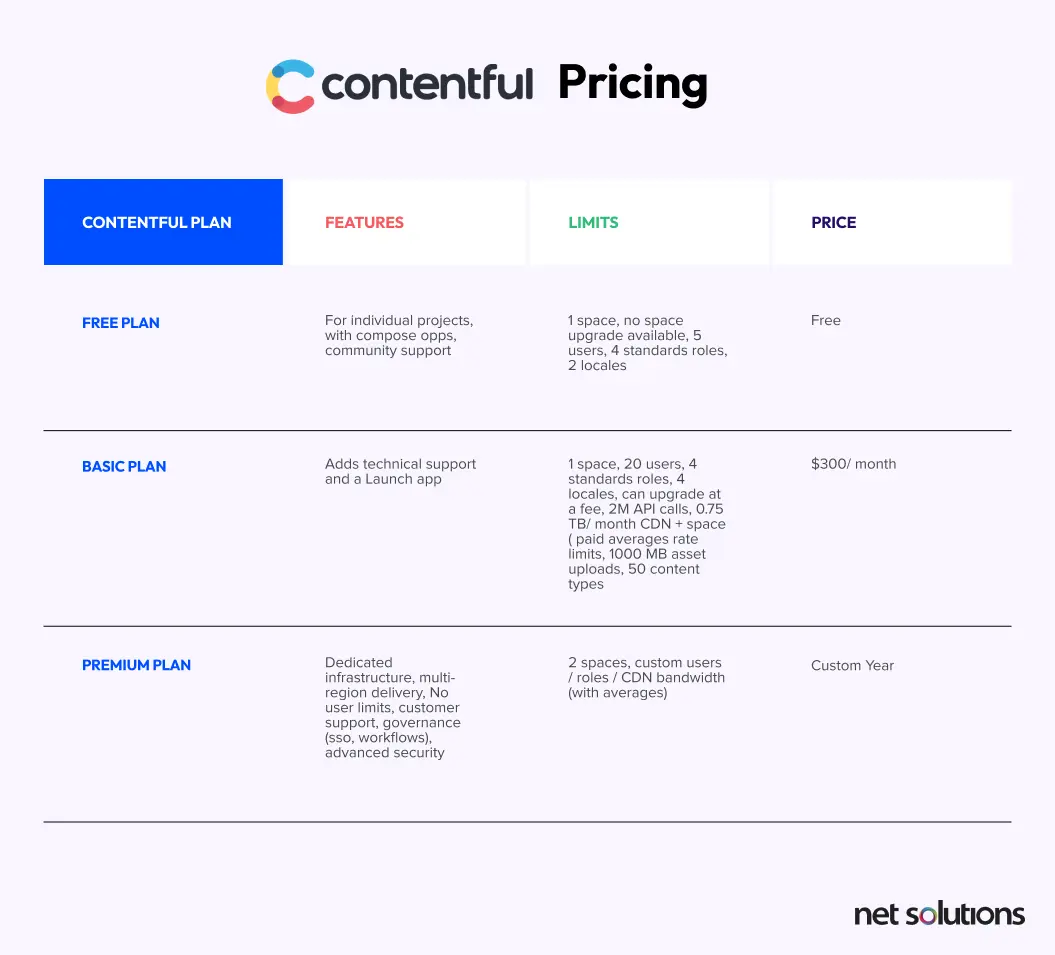The main difference between Drupal and Contentful is that Drupal is an open-source content management system (CMS) that can be used as both a traditional and headless CMS, while Contentful is a headless software-as-a-service (SaaS) CMS.
Both Drupal and Contentful are powerful CMS options with a strong history of innovation and strong functionality, including recent releases of Drupal 11 and Drupal Starshot (prototype) and Contentful Content Studio and Contentful AI. However, there are distinct pros and cons to each platform.
In this guide, you will find a full comparison between these two CMS platforms, including a comparison of:
- Traditional vs headless CMS
- The pros and cons of an open-source CMS like Drupal
- Drupal vs Contentful comparisons over key capabilities including: scalability, performance, security, features, and ease of use
- Real insights from users about each platform
Disclaimer: The information below is accurate as of September 27, 2024.
Traditional vs Headless CMS
In a traditional content management system (CMS), the tech stack is combined (front-end and back-end). A traditional CMS formats content one way, so it may not perform as well or cater to specific features of a particular channel.
Both Drupal and Contentful can be used as a headless CMS, decoupling the front-end (what you see) and back-end (where content sits) to make it easier and faster to deploy composable content to any digital touchpoint. A headless CMS allows for custom front-ends to be created and optimized to support content delivery to each channel / digital touchpoint. If you want to learn more, read our headless CMS vs traditional CMS guide.

Contentful is a headless CMS by default, while Drupal can be used in both a traditional and headless capacity. Let’s move on and examine both CMS platforms in detail.
For more on the distinction between traditional CMS and Headless CMS, read our post on traditional CMS vs. headless CMS.
Read MoreDrupal Overview
Drupal is a free and open-source CMS designed to help organizations create websites and applications, known for strong security, accessibility, scalability, and community support (with more than 1500 people contributing to Drupal each month).
Drupal is used by 1.3% of global websites, powering 15% of the top 10,000 global websites that use open-source software including NBC, NASA and UNICEF. Drupal can be described both as a CMS and a content management framework, a system that drives flexibility over what can be built.
Drupal announced the latest version of its CMS, Drupal 11, in August 2024. Drupal 11 includes performance improvements, security updates, a more intuitive interface, and new features. Drupal 11 was created with headless CMS in mind, making structured content and workflows easier and more flexible.
Key features of Drupal
The standard release of Drupal is known as “Drupal core,” with interchangeable and stackable “modules” that build on it. Let’s examine some of the key features of Drupal:
- Accessible & Multilingual: Drupal supports more than 100 languages and includes accessibility as a core goal, ensuring all features align with W3C’s web accessibility initiative.
- Personalization: Drupal can leverage location, browser history, device and behavior to build personalizations in marketing activities. Drupal modules in AI can assist in creating personalizations at scale.
- Flexible architecture: Drupal can be used both traditional or headless, with Drupal’s API-first approach supporting content composability. Drupal 11 makes structured content easier and natively supports Single-Directory Components to simplify front-end development.
- Drupal AI: The Drupal AI module combines features from AI Interpolator, OpenAI, Search API AI and other modules in a unified framework to make it easier to integrate third-party AI services into your Drupal website.
- Recipes & Starshot (prototype): The Starshot initiative will create “Drupal CMS” (likely), utilizing the Drupal core with “recipes” that make it easier for non-technical users to create an out-of-the-box download of Drupal that’s more ready-to-use, along with automated updates. Starshot and Drupal 11 also use “recipes” to apply predefined components.
Benefits of using Drupal
Here are some reasons developers and businesses choose to work with Drupal:
1. Flexible & extensible
52,000+ modules and 3000+ themes extend / add or override default elements without impacting the core code, the vast majority of which are free. Drupal modules also include integrations with third-party systems and are easy to create to support custom integrations with internal systems.
2. Secure
Drupal is a mature and stable system that has extensive developer input and testing by an industry-leading security team. Drupal includes robust security features for access control, encryption and malicious entry prevention, making a trusted choice by governments.
3. Scalable performance
Built-in caching and rendering, combined with a global CDN, can help deliver lightning-fast content to large and multi-channel sites.
4. Powerful for developers
Drupal is driven by developers with many features and capabilities designed to make life easier for developers, with a detailed interface, helpful tools, infinite customizability and a massive community of support. Drupal 11’s includes modular architecture that is easier to extend and a workspace module that makes it easier to develop and test, minimizing risk on the main site.
Drawbacks of Drupal
There are several reasons why you may not want to use Drupal:
1. Complexity & steep learning curve
The infinite flexibility of Drupal also introduces complexity. Drupal is known for being developer-resource heavy, although Drupal has been chipping away at this barrier with the release of Drupal 11, which is easier to use for non-technical users.
2. Self-managed
While being self-managed offers more control (and open-source code can be modified), Drupal sites require investing in a tech stack: server software, database software, PHP interpreting software. Drupal also requires developers to take ownership of updates, maintenance and security. The need to set up and configure Drupal makes it less of an “out-of-the-box” solution (for now, looking at Starshot).
3. Performance isn’t always guaranteed
Although Drupal core is built for performance, the heavy reliance on modules can introduce performance issues that require significant developer resources to reduce bloat, eliminate module compatibility issues, and optimize for performance.
Drupal Pricing
Drupal is free and open-source, but it is critical to consider the total cost of ownership associated with an open-source platform including hosting, development, design, maintenance, and security. A headless implementation of Drupal requires more extensive development time and resources.
Contentful Overview
Contentful is a full-featured headless and composable CMS that supports omnichannel, multi-brand experiences. Contentful is our top choice for top headless CMS, for its flexibility, strong API, robust developer tools, and highly intuitive interface. Contentful is used by 30% of Fortune 500 companies. Learn more in our Guide to Contentful.
Key features of Contentful
Contentful is continually being updated with new and advanced features that are built into the hosted platform:
1. Content Studio
The Contentful Content Studio (paid add-on) uses patterns, design tokens and a drag-and-drop canvas to make it faster to create experiences. Developers take time to set up guardrails to protect brand integrity and optimal deployment, supporting subsequent independent content creation.
2. Artificial intelligence
Contentful AI is built into both the Platform and Studio to quickly build new content types, generate content, translate it to nearly 100 languages, and generate images from OpenAI.
3. Localization
Contentful supports multi-region using the concept of Locales. Contentful can support over 100 languages.
Benefits of using Contentful
Contentful is known for the following benefits, which also stand out in comparison to Drupal:
1. Easy to use
Contentful is particularly user-friendly for non-technical users such as content editors and marketers with a simple rich text editor, AI workflows to support content generations and image optimization, and the Content Studio drag-and-drop canvas (add-on). Contentful includes real-time content collaboration, rollbacks, annotations, and work assignments (via the Tasks app).
2. Digital experience platform (DXP)
Contentful is also recognized as a digital experience platform due to its focus on creating reusable experiences that can be delivered to multiple touchpoints, with guardrails that maintain brand consistency.
3. Extensible
Contentful has a rich ecosystem of plug-and-play solutions via its Marketplace, as well as the Contentful App Framework, tools, many SDKs, field editors, and Forma 36 library to help build custom apps, link apps together to build and automate complex workflows, and Next.js and Contentful templates to support basic marketing or eCommerce websites or a blog.
4. Managed platform
Contentful is a SaaS (cloud-based platform), coming with the benefit of offloading the back-end tech stack requirements (front-end requirements still exist for headless), including tasks around maintenance and security. Contentful offers a strong security position, including support for SSO, elevated identity and access management, encryption, and backups. Contentful runs a bug bounty program and complies with various laws and regulations including ISO 27001, PCI-DSS, and EU residency requirements.
Drawbacks of Contentful
Despite the benefits of a hosted platform designed for easy content experience creation, Contentful does have some drawbacks:
1. Paywalls
Some of the best features of Contentful (Tasks, Compose and Launch app as well as Contentful Studio) are only available at higher price tiers or as additional add-on products.
2. Content model challenges
Although Drupal 11 also supports a structured content model, Contentful’s content model can be both powerful and a drawback. If the content model is not set up correctly, it can be difficult to revise. In order to avoid this, it’s critical to choose an experienced Contentful partner.
"Creating the ideal content architecture is a significant undertaking. Teams must build modules and templates from scratch, which requires thoughtful planning to align with business objectives. Contentful’s built-in rich text editor had limitations for advanced use cases. We had to develop custom extensions for better functionality and to integrate multimedia effectively."
Full Stack Web Developer, Retail
3. Customization requires developers
While the platform is extensible, it does not have the volume of “modules”, or in this case extensions, that set Drupal apart, requiring more custom development to adjust features, capabilities or integrations. Customizations require ongoing development maintenance.
Contentful Pricing
Contentful has the Contentful Platform, which has a free plan and two paid tiers, and the Contentful Studio, a paid add-on (custom price per year). Learn more about various Contentful pricing plans.

As Contentful is growing in popularity, it is often being pitted against other CMS platforms. If you want to know how it stacks up against popular alternatives, read our guides on the following:
RECOMMENDED READING
Drupal and Contentful: Quick Comparison
As Drupal and Contentful are both feature-rich, flexible, scalable and secure headless CMS, we’ve put together a table to help compare the two platforms at a more granular level.

Drupal vs Contentful: What Users Have to Say
In this unbiased comparison of Drupal vs Contentful, we will share some reviews from the peer-to-peer review site G2.
What users have to say about Drupal?
G2 users say Drupal is:
Pros:
- Allows for a high degree of flexibility without custom coding – Omar S.
- Robust and comprehensive security – Sheila S.
- Can support complex applications and websites – IT user
Cons:
- Upgrading between major versions can be time-confusing and complicated – IT user
- Less visually intuitive out-of-the-box than other CMS options – Brian S.
- Time consuming to set up – Mbili M.
What users have to say about Contentful?
G2 users say Contentful is:
Pros:
- Developer-oriented and easy to use API – Oskari G.
- Scalable and reliable, with no service interruptions in the past 5 years – Christian M.
- Customer support is reliable and fast – Computer software user
Cons:
- Requires the assistance of custom development services for many integrations – Computer software user & Oskari G.
- The built-in features and capabilities can be overwhelming at first – Dheeraj S.
“While Drupal offers a solid foundation for content management, it often requires extensive customization and ongoing maintenance to meet the evolving needs of modern retail. Contentful, on the other hand, provides a flexible, API-first approach that scales effortlessly across channels, enabling faster time to market and richer digital experiences. For omnichannel retailers, the move to Contentful isn’t just an upgrade—it’s a strategic enabler.”
Senior Technical Architect, Retail
The Bottom Line
Both Contentful and Drupal are highly customizable headless CMS solutions that can meet the needs of small and enterprise clients, but when it comes down to what customizations you need and the ease of content creation you’re looking for, the tools are very different:
What is Drupal best for?
Drupal is best for anyone looking for an extreme degree of flexibility who has the developer resources to manage a tech stack. Drupal is best for.
- Complex websites
- Custom apps
- High security websites
- Knowledge bases and portals
- Blogs
- Forums
- eCommerce sites
What is Contentful best for?
Contentful is ideal for small and enterprise businesses who are looking for an scalable, easy-to-use platform that has strong developer support and accelerated content solutions (with AI), ideal for:
- Websites
- Mobile apps
- Knowledge bases or portals
- Interactive guides
- eCommerce sites
Ready to get started?
If you’re looking for a composable headless CMS platform to take your content experiences to the next level, whether you want Drupal or Contentful, Net Solutions is happy to help. We offer Custom eCommerce Development Services and are proud partners with Contentful, which has a track record of supporting global brands to reach new heights. You can read about our Contentful development services here, in greater detail, to see how we can help you optimize your content strategy.



